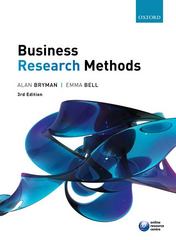Answered step by step
Verified Expert Solution
Question
1 Approved Answer
1 . A situation that arises when all alternative choices or behaviors have been deemed undesirable because of the potentially negative ethical consequences, making it
A situation that arises when all alternative choices or behaviors have been deemed undesirable because of the potentially negative ethical consequences, making it difficult to distinguish right from wrong, is considered:
adiscretionary responsibility
ba moral agent
ca social responsibility.
dan ethical dilemma
Any group within or outside the organization that has a stake in the organization's performance is called:
aan international customer.
ba supplier.
ca trade association.
da stakeholder.
Human Resources has just published a manual that clearly states the rules for handling employee grievances. The school makes it clear to employees that rules will be administered fairly and consistently. Lehman College operates on:
athe individual approach.
bthe procedural justice approach.
cthe utilitarian approach.
dthe defensive approach.
Which of the following ethical standards argue that moral behaviors produce the greatest good for the greatest number?
aUtilitarian
bmoral rights
cIndividualism
dJustice
When an organization decides to produce a new product, this falls within the domain of:
aethics
bfree choice.
ccodified law.
dcompensatory justice.
When fundamental rights and liberties cannot be taken away by another individual's decision, the ethical decision making approach is known:
anone of these
bmoralrights approach
cutilitarian approach.
dindividualism approach.
refers to the concept that different treatment of people should not be based on arbitrary characteristics.
aMoraljustice
bProcedural justice
cCompensatory justice
dDistributive justice
Which of the following oversees all aspects of responding to widespread financial wrongdoing?
aChief Strategic Officer
bChief Executive Officer
cChief Operating Officer
dChief Ethics Officer
The FDA has not approved a new drug to sell in the US because further testing is needed. The company has a chance to sell its product in another country immediately to start recovering the costs of R & D and production three years ahead of time. This example places the decision in which of the categories from the text?
aThe obstructive category
bThe domain of free choice
cThe ethical domain
dThe legal domain
Which of the following rights are NOT considered as one of the moral rights during decisionmaking?
aThe right to free consent
bThe right to free speech.
cThe right of freedom of conscience.
dThe right to invade privacy.
Which of the following appropriately describes the organizational culture aimed both at high productivity and strong culture?
aHighcontext culture
bInterpersonal culture
cLowcontext culture
dPower culture
All of the following includes political risk facing a business organization in a host foreign country, EXCEPT:
alaws and regulations
bloss of assets
cfinancial crisis
dtariffs, quotas, taxes
All of the following are considered emerging economies EXCEPT
aAustralia
bRussia
cBrazil
dSouth Africa
Your company is interested in producing and marketing a line of coffee that will penetrate the Chinese market. Your firm is willing to supply the equipment, products, product ingredients, trademark, and standardized operating system to entrepreneurs. What type of strategy are you going to use?
aA greenfield venture agreement
bAn export agreement
c a franchise
dWholly owned foreign affiliate
Companies that place an emphasis on their home countries are called
aGeocentric
bPolycentric
cEthnocentric
dGlobal
When a company builds a subsidiary from scratch in a foreign country, this is called:
asubsidiary
blocal affiliate
cwholly owned affiliate
dgreenfield venture
Resource development, inflation, and exchange rates all describe which factor in the international environment?
aLegal
bSociocultural
cPolitical
dEconomic
What criterion do we traditionally used to classify countries as developed or developing?
aGINI Index
bper capita income
clevel of education
dmortality rate
Which of the following is an entry strategy in which the organization maintains its production facilities within its home country and transfers its products for sale in foreign markets?
aGreenfield venture
bFranchising
cLicensing
dExporting
You own a company in Mexico that is having difficulty getting the local farmers to supply you with the proper ingredients. This is a problem with Mexico's:
aresource market
binfrastructure
cproduct market.
deconomy
Which of the following cultures describe valuing and rewarding a systematic, rational, methodical way of doing things?
aInvolvement culture
bAchievement culture
cConsistency culture
dAccomplishment culture
When companies use sophisticated software to search through large amounts of internal and external data to spot patterns, trends, and relationships, they are essentially doing:
aPartnership intelligence
bMerger intelligence
cBusiness intelligence
dCompetitive intelligence
Step by Step Solution
There are 3 Steps involved in it
Step: 1

Get Instant Access to Expert-Tailored Solutions
See step-by-step solutions with expert insights and AI powered tools for academic success
Step: 2

Step: 3

Ace Your Homework with AI
Get the answers you need in no time with our AI-driven, step-by-step assistance
Get Started


